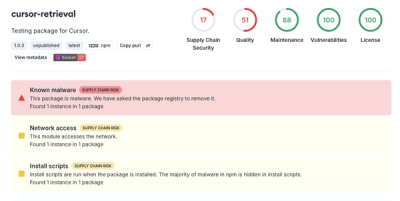
Security News
The Risks of Misguided Research in Supply Chain Security
Snyk's use of malicious npm packages for research raises ethical concerns, highlighting risks in public deployment, data exfiltration, and unauthorized testing.
github.com/meteorsliu/websocket
WebSocket library for fasthttp and net/http.
Checkout examples to inspire yourself.
go get github.com/dgrr/websocket
Other WebSocket packages DON'T allow concurrent Read/Write operations on servers and they do not provide low level access to WebSocket packet crafting. Those WebSocket packages try to emulate the Golang API by implementing io.Reader and io.Writer interfaces on their connections. io.Writer might be a good idea to use it, but no io.Reader, given that WebSocket is an async protocol by nature (all protocols are (?)).
Sometimes, WebSocket servers are just cumbersome when we want to handle a lot of clients in an async manner. For example, in other WebSocket packages to broadcast a message generated internally we'll need to do the following:
type MyWebSocketService struct {
clients sync.Map
}
type BlockingConn struct {
lck sync.Mutex
c websocketPackage.Conn
}
func (ws *MyWebSocketService) Broadcaster() {
for msg := range messageProducerChannel {
ws.clients.Range(func(_, v interface{}) bool {
c := v.(*BlockingConn)
c.lck.Lock() // oh, we need to block, otherwise we can break the program
err := c.Write(msg)
c.lck.Unlock()
if err != nil {
// we have an error, what can we do? Log it?
// if the connection has been closed we'll receive that on
// the Read call, so the connection will close automatically.
}
return true
})
}
}
func (ws *MyWebSocketService) Handle(request, response) {
c, err := websocketPackage.Upgrade(request, response)
if err != nil {
// then it's clearly an error! Report back
}
bc := &BlockingConn{
c: c,
}
ws.clients.Store(bc, struct{}{})
// even though I just want to write, I need to block somehow
for {
content, err := bc.Read()
if err != nil {
// handle the error
break
}
}
ws.clients.Delete(bc)
}
First, we need to store every client upon connection, and whenever we want to send data we need to iterate over a list, and send the message. If while, writing we get an error, then we need to handle that client's error What if the writing operation is happening at the same time in 2 different coroutines? Then we need a sync.Mutex and block until we finish writing.
To solve most of those problems websocket uses channels and separated coroutines, one for reading and another one for writing. By following the sharing principle.
Do not communicate by sharing memory; instead, share memory by communicating.
Following the fasthttp philosophy this library tries to take as much advantage of the Golang's multi-threaded model as possible, while keeping your code concurrently safe.
To see an example of what this package CAN do that others DONT checkout the broadcast example.
It's quite easy. You only need to create a Server, set your callbacks by calling the Handle* methods and then specify your fasthttp handler as Server.Upgrade.
package main
import (
"fmt"
"github.com/valyala/fasthttp"
"github.com/dgrr/websocket"
)
func main() {
ws := websocket.Server{}
ws.HandleData(OnMessage)
fasthttp.ListenAndServe(":8080", ws.Upgrade)
}
func OnMessage(c *websocket.Conn, isBinary bool, data []byte) {
fmt.Printf("Received data from %s: %s\n", c.RemoteAddr(), data)
}
package main
import (
"fmt"
"net/http"
"github.com/dgrr/websocket"
)
func main() {
ws := websocket.Server{}
ws.HandleData(OnMessage)
http.HandleFunc("/", ws.NetUpgrade)
http.ListenAndServe(":8080", nil)
}
func OnMessage(c *websocket.Conn, isBinary bool, data []byte) {
fmt.Printf("Received data from %s: %s\n", c.RemoteAddr(), data)
}
Pings are handle automatically by the library, but you can get the content of those pings setting the callback using HandlePing.
For example, let's try to get the round trip time to a client by using the PING frame. The website http2.gofiber.io uses this method to measure the round trip time displayed at the bottom of the webpage.
package main
import (
"sync"
"encoding/binary"
"log"
"time"
"github.com/valyala/fasthttp"
"github.com/dgrr/websocket"
)
// Struct to keep the clients connected
//
// it should be safe to access the clients concurrently from Open and Close.
type RTTMeasure struct {
clients sync.Map
}
// just trigger the ping sender
func (rtt *RTTMeasure) Start() {
time.AfterFunc(time.Second * 2, rtt.sendPings)
}
func (rtt *RTTMeasure) sendPings() {
var data [8]byte
binary.BigEndian.PutUint64(data[:], uint64(
time.Now().UnixNano()),
)
rtt.clients.Range(func(_, v interface{}) bool {
c := v.(*websocket.Conn)
c.Ping(data[:])
return true
})
rtt.Start()
}
// register a connection when it's open
func (rtt *RTTMeasure) RegisterConn(c *websocket.Conn) {
rtt.clients.Store(c.ID(), c)
log.Printf("Client %s connected\n", c.RemoteAddr())
}
// remove the connection when receiving the close
func (rtt *RTTMeasure) RemoveConn(c *websocket.Conn, err error) {
rtt.clients.Delete(c.ID())
log.Printf("Client %s disconnected\n", c.RemoteAddr())
}
func main() {
rtt := RTTMeasure{}
ws := websocket.Server{}
ws.HandleOpen(rtt.RegisterConn)
ws.HandleClose(rtt.RemoveConn)
ws.HandlePong(OnPong)
// schedule the timer
rtt.Start()
fasthttp.ListenAndServe(":8080", ws.Upgrade)
}
// handle the pong message
func OnPong(c *websocket.Conn, data []byte) {
if len(data) == 8 {
n := binary.BigEndian.Uint64(data)
ts := time.Unix(0, int64(n))
log.Printf("RTT with %s is %s\n", c.RemoteAddr(), time.Now().Sub(ts))
}
}
| Features | websocket | Gorilla | Nhooyr | gowabs |
|---|---|---|---|---|
| Concurrent R/W | Yes | No | No. Only writes | No |
| Passes Autobahn Test Suite | Mostly | Yes | Yes | Mostly |
| Receive fragmented message | Yes | Yes | Yes | Yes |
| Send close message | Yes | Yes | Yes | Yes |
| Send pings and receive pongs | Yes | Yes | Yes | Yes |
| Get the type of a received data message | Yes | Yes | Yes | Yes |
| Compression Extensions | No | Experimental | Yes | No (?) |
| Read message using io.Reader | No | Yes | No | No (?) |
| Write message using io.WriteCloser | Yes | Yes | No | No (?) |
The following stress test were performed without timeouts:
Executing tcpkali --ws -c 100 -m 'hello world!!13212312!' -r 10k localhost:8081 the tests shows the following:
Total data sent: 267.7 MiB (280678466 bytes)
Total data received: 229.5 MiB (240626600 bytes)
Bandwidth per channel: 4.167⇅ Mbps (520.9 kBps)
Aggregate bandwidth: 192.357↓, 224.375↑ Mbps
Packet rate estimate: 247050.1↓, 61842.9↑ (1↓, 1↑ TCP MSS/op)
Test duration: 10.0075 s.
Total data sent: 267.3 MiB (280320124 bytes)
Total data received: 228.3 MiB (239396374 bytes)
Bandwidth per channel: 4.156⇅ Mbps (519.5 kBps)
Aggregate bandwidth: 191.442↓, 224.168↑ Mbps
Packet rate estimate: 188107.1↓, 52240.7↑ (1↓, 1↑ TCP MSS/op)
Test duration: 10.0039 s.
Either for fasthttp and net/http should be quite close, the only difference is the way they both upgrade.
Total data sent: 260.2 MiB (272886768 bytes)
Total data received: 109.3 MiB (114632982 bytes)
Bandwidth per channel: 3.097⇅ Mbps (387.1 kBps)
Aggregate bandwidth: 91.615↓, 218.092↑ Mbps
Packet rate estimate: 109755.3↓, 66807.4↑ (1↓, 1↑ TCP MSS/op)
Test duration: 10.01 s.
Total data sent: 224.3 MiB (235184096 bytes)
Total data received: 41.2 MiB (43209780 bytes)
Bandwidth per channel: 2.227⇅ Mbps (278.3 kBps)
Aggregate bandwidth: 34.559↓, 188.097↑ Mbps
Packet rate estimate: 88474.0↓, 55256.1↑ (1↓, 1↑ TCP MSS/op)
Test duration: 10.0027 s.
Total data sent: 265.8 MiB (278718160 bytes)
Total data received: 117.8 MiB (123548959 bytes)
Bandwidth per channel: 3.218⇅ Mbps (402.2 kBps)
Aggregate bandwidth: 98.825↓, 222.942↑ Mbps
Packet rate estimate: 148231.6↓, 72106.1↑ (1↓, 1↑ TCP MSS/op)
Test duration: 10.0015 s.
The source files are in this folder.
FAQs
Unknown package
Did you know?

Socket for GitHub automatically highlights issues in each pull request and monitors the health of all your open source dependencies. Discover the contents of your packages and block harmful activity before you install or update your dependencies.

Security News
Snyk's use of malicious npm packages for research raises ethical concerns, highlighting risks in public deployment, data exfiltration, and unauthorized testing.

Research
Security News
Socket researchers found several malicious npm packages typosquatting Chalk and Chokidar, targeting Node.js developers with kill switches and data theft.

Security News
pnpm 10 blocks lifecycle scripts by default to improve security, addressing supply chain attack risks but sparking debate over compatibility and workflow changes.